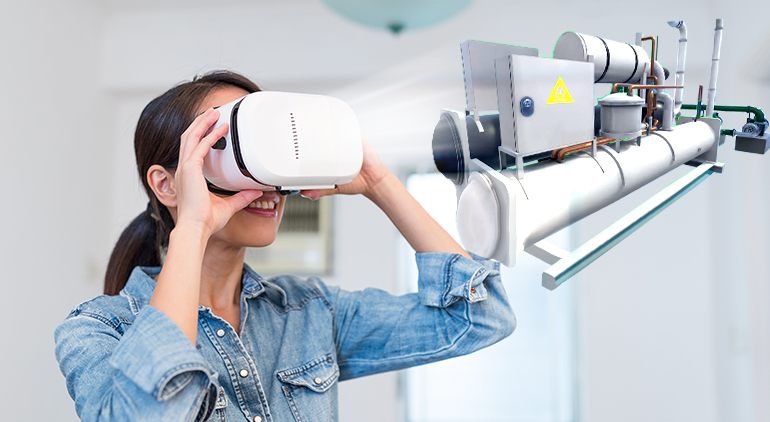Virtual Industrial Visits: The Future of Field Trips for Engineering Students

The Indian higher education sector holds huge potential with an estimated 150 million people in the 18-23 age group. It is rightly called the “Sunrise Sector owing to the innovation and investments it attracts. Recently, technology adoption is driving the sector. Virtual reality is at the forefront.
A shift is seen from conventional means of education to incorporate more real-world technical training and skill-building through a better understanding of abstract concepts.
To date, one of the shifts seen in the higher education technology trends is the added integration of industrial visits. Let us take a glance at this.
Industrial Visits
When it comes to engineering, a prominent method of value-added education is industrial visits. Holistic learning is never complete with textbooks and lectures.
Hands-on education is a necessity. It provides a better understanding of how concepts are transformed into action and applied in real-world scenarios.
The recess between theoretical learning and practical applications is bridged by these visits. It also gives a better understanding of the overall organizational function as well as interpersonal and communication skills that students need to foster.
So if the gaps are already bridged, what is the necessity of a virtual industrial visit?
Virtual Industrial Visits
Accessibility is the one-word answer. With remote education taking a center stage in the higher education sphere, virtual industrial visits with the help of VR in higher education promise an annexure of the physical experience. Hardware and software advancements have lubricated the adoption greatly.
Virtual industrial visits also boost retention as the students can explore the premises at their own pace, giving attention to what interests them.
With the integration of a virtual tour guide, essential information can also be overlaid within the immersive technology in the college classrooms environment leading to better learning outcomes.
It also increases the possibilities of experimentation. Virtual visits can have the added sophistication of being able to interact with industrial settings. An actual industrial visit may limit this possibility.
This is mainly due to the hazardous nature of the working of factories and industries and the potential faulty handling of equipment by the students. Through VR, this risk factor is eliminated, giving rise to experimental possibilities.
Another limitation of traditional industrial visits is restricted sites. Certain industries or factories or certain sections within industries may not be accessible to students. Some key industries may not permit visits either.
 Get the App from Meta Store: Download Now
Get the App from Meta Store: Download Now
Through VR, a to-scale replica of any industry or factory, or site can be replicated and students can be given unrestricted access to each and every nook and corner of the site.
These benefits paint a better picture of virtual industrial visits over the traditional alternative. Let us take a look at a site within VR industrial visits to glance at the possibilities.
Virtual Industrial Visits: A Use Case
Thermal Power Plants
A comprehensive guide about the workings of various components of a thermal power plant is given to the students. This can include elements such as coal storage, coal crusher, coal hopper, primary fan, combustion chamber, electrostatic precipitator, steam turbines, and the various pipes and their deployments.
Real-world authenticity is created in a safe, immersive environment. The plants are designed based on insights and inputs from industry experts.
Integrating an AI-powered bot can help the students glide seamlessly through the stages of the tour after selecting their learning objectives. These objectives can include identifying the equipment or understanding the safety measures.
X-ray views of each component can be included to give a better understanding of its intricate functioning. For instance, the various outlets of a condenser can be marked such as steam going to and fro cooling towers, or towards the economizer.
Such detailed and guided visits help students for industry acclimatization and to be better equipped with practical knowledge for their jobs.
Many leading institutions across the globe have already started experimenting with the tech and integrating virtual reality-powered industrial visits into their curriculum.
For instance, GNIMT organized a virtual industry visit to Hero Steels to give the students a better understanding of Hydrogen Annealing batch Furnaces.
Let us conclude by understanding the global scenario of widespread VR adoption into the educational and ed-tech fields.
Related Post: VR for Understanding Fluid Mechanics and Centrifugal Pump
Conclusion
The increase in online education is what has driven the tech-forward so much. The convenience and added accessibility have attracted students too.
• According to PRNews, the online tutoring market is expected to have a growth of $132 Billion from 2020 to 2024.
• The growth will be accelerated by a CAGR of 15%.
• The growth of STEM education and the need for an innovative approach to education are definitely driving the edtech market.
• According to MarketWatch, the STEM (Science, Technology, Engineering, and Mathematics) market is expected to exhibit a CAGR of 5% from 2021 to 2023.
• The education tech market was at $89.49 Billion in 2020.
• From 2021 to 2028. Edtech is expected to reach a CAGR of 19.9%.
Market Reports World predicts a shift in education dynamics as a global lean towards context-based education is observed. Hands-on learning is gaining traction.
At iXR Labs, we have a different take on education. We believe in a tech-centered approach. We understand the needs of the modern learner and we sculpt our tech to be cutting-edge in the industry. To know more, visit us at www.ixrlabs.com.




